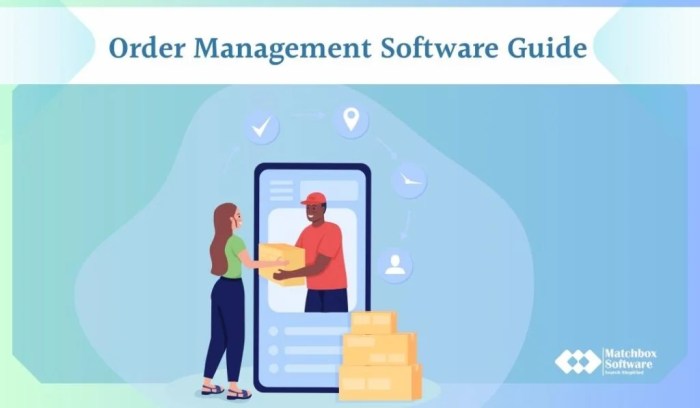Crm and order management software – In today’s dynamic business environment, efficient management of customer relationships and orders is paramount for success. Integrating Customer Relationship Management (CRM) and Order Management Software (OMS) systems can significantly streamline operations, boost sales, and enhance customer satisfaction. This comprehensive guide delves into the intricacies of both systems, exploring their individual functionalities, the benefits of integration, and how they can transform your business processes.
Understanding Customer Relationship Management (CRM) Software
CRM software is a technology designed to manage and analyze customer interactions and data throughout the customer lifecycle. It helps businesses understand customer needs, improve customer service, and increase sales. Key features of a robust CRM system include:
Core CRM Features:
- Contact Management: Centralized storage and management of customer information, including contact details, communication history, and purchase history.
- Sales Force Automation (SFA): Tools to streamline sales processes, such as lead management, opportunity tracking, and sales forecasting.
- Marketing Automation: Automated marketing campaigns, email marketing, and social media management to nurture leads and engage customers.
- Customer Service Management: Tools for managing customer inquiries, resolving issues, and tracking customer satisfaction.
- Reporting and Analytics: Dashboards and reports to track key performance indicators (KPIs) and gain insights into customer behavior.
Types of CRM Systems:
- Operational CRM: Focuses on automating and improving business processes, such as sales, marketing, and customer service.
- Analytical CRM: Uses data analysis to understand customer behavior and improve decision-making.
- Collaborative CRM: Facilitates communication and collaboration between different departments and teams.
Examples of popular CRM platforms include Salesforce, HubSpot, Zoho CRM, and Microsoft Dynamics 365. The choice of CRM system depends on the specific needs and size of the business.
Understanding Order Management Software (OMS)
Order management software (OMS) is a system that automates and streamlines the entire order fulfillment process, from order placement to delivery. It integrates with various systems, including e-commerce platforms, inventory management systems, and shipping carriers, to provide a seamless customer experience.
Key OMS Features:
- Order Entry and Processing: Automated order capture and processing, reducing manual data entry and errors.
- Inventory Management: Real-time tracking of inventory levels, preventing stockouts and overstocking.
- Warehouse Management: Optimization of warehouse operations, including picking, packing, and shipping.
- Shipping and Delivery: Integration with shipping carriers for automated label generation and tracking.
- Returns Management: Streamlined process for handling customer returns and exchanges.
- Order Tracking and Visibility: Real-time tracking of orders, providing customers with up-to-date information.
Benefits of Using OMS:
- Improved Order Accuracy: Reduced errors in order processing, leading to increased customer satisfaction.
- Faster Order Fulfillment: Streamlined processes result in quicker delivery times.
- Reduced Costs: Automation reduces labor costs and minimizes errors.
- Enhanced Customer Experience: Real-time order tracking and proactive communication improve customer satisfaction.
- Increased Efficiency: Optimized warehouse operations and inventory management improve overall efficiency.
The Power of Integrating CRM and OMS
Integrating CRM and OMS systems creates a powerful synergy that enhances business operations and customer relationships. This integration allows for a seamless flow of information between sales, marketing, and order fulfillment teams. Key benefits include:

Source: matchboxsoftware.com
Benefits of CRM and OMS Integration:, Crm and order management software
- 360-Degree Customer View: Access to a complete view of customer interactions and order history, enabling personalized service and targeted marketing.
- Improved Sales Forecasting: Accurate sales data from OMS informs CRM forecasting, leading to better resource allocation.
- Enhanced Customer Service: Agents have access to complete order history, allowing for quicker resolution of customer issues.
- Streamlined Order Fulfillment: Automated order processing and inventory management reduce delays and errors.
- Increased Revenue: Improved customer satisfaction and efficient operations lead to increased sales and profitability.
- Better Inventory Management: Real-time data from both systems provides a more accurate picture of inventory levels, minimizing stockouts and waste.
Choosing the Right CRM and OMS Solution: Crm And Order Management Software
Selecting the right CRM and OMS systems requires careful consideration of your business needs and budget. Factors to consider include:

Source: nioyatech.com
- Business Size and Complexity: Choose a system that scales with your business growth.
- Integration Capabilities: Ensure seamless integration with existing systems.
- Budget: Consider the cost of software, implementation, and ongoing maintenance.
- User-Friendliness: Select a system that is easy to use and understand for your team.
- Scalability and Flexibility: Choose a system that can adapt to your changing business needs.
Frequently Asked Questions (FAQ)
- Q: What is the difference between CRM and OMS?
A: CRM focuses on managing customer relationships and data, while OMS focuses on automating the order fulfillment process. They are distinct but complementary systems. - Q: Do I need both CRM and OMS software?
A: While not strictly required, integrating both systems offers significant advantages in efficiency, customer satisfaction, and revenue growth. The need depends on the complexity of your business operations. - Q: How much does CRM and OMS software cost?
A: Costs vary widely depending on the features, scalability, and vendor. Expect a range from affordable cloud-based solutions to enterprise-level systems with significant upfront investment. - Q: How long does it take to implement CRM and OMS software?
A: Implementation time depends on the complexity of the system and the size of your business. It can range from a few weeks to several months. - Q: What are the key benefits of integrating CRM and OMS?
A: Key benefits include a 360-degree customer view, improved sales forecasting, enhanced customer service, streamlined order fulfillment, and increased revenue.
Conclusion
Implementing CRM and OMS software, especially when integrated, is a strategic investment that can significantly improve your business operations and customer relationships. By automating processes, gaining valuable insights into customer behavior, and streamlining order fulfillment, you can enhance efficiency, boost sales, and achieve sustainable growth. Careful consideration of your business needs and the selection of the right software solutions are crucial for maximizing the return on your investment.
References
Call to Action
Ready to transform your business processes and elevate your customer experience? Contact us today for a consultation to explore how integrated CRM and OMS solutions can benefit your organization.
FAQ Section
What are the key benefits of using integrated CRM and order management software?
Key benefits include improved efficiency, enhanced customer satisfaction, better data analysis for informed decision-making, reduced errors, and increased profitability.
How much does CRM and order management software typically cost?
Pricing varies widely depending on the features, scalability, and vendor. Expect a range from affordable monthly subscriptions to substantial upfront investments for enterprise-level solutions.
What are some common integration challenges?
Common challenges include data migration complexities, system compatibility issues, and the need for robust employee training to effectively utilize the integrated system.
How long does it typically take to implement CRM and order management software?
Implementation timelines vary significantly based on the size and complexity of the business, the chosen software, and the level of customization required. It can range from a few weeks to several months.
Can CRM and order management software integrate with my existing systems?
Many solutions offer robust API integrations, allowing compatibility with a wide range of existing systems. However, it’s crucial to verify compatibility before purchasing.
